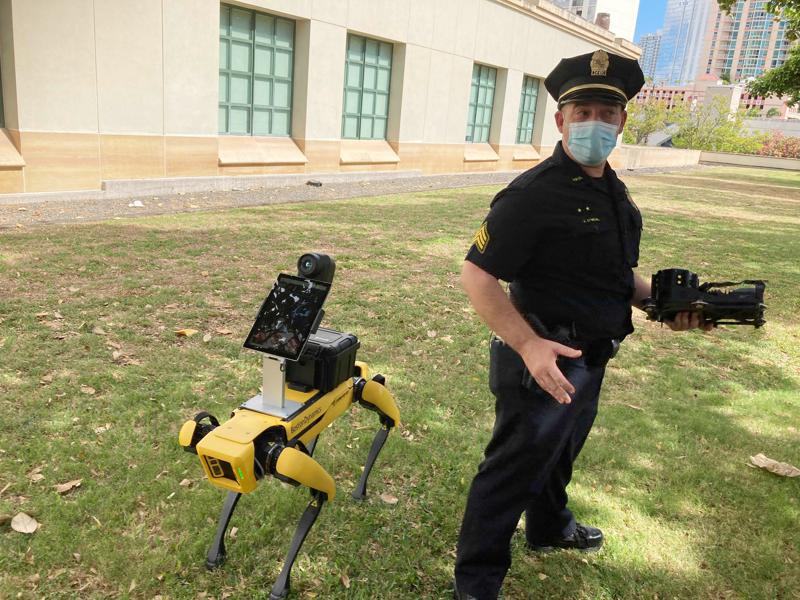Robotic police canines: Useful dogs or dehumanizing machines?

HONOLULU — If you’re destitute and searching for transitory asylum in Hawaii’s capital, expect a visit from an automated police canine that will examine your eye to ensure you don’t have a fever.
That is only one of the manners in which public wellbeing offices are beginning to utilize Spot, the most popular of another business classification of robots that jog around with creature like deftness.
The modest bunch of police authorities exploring different avenues regarding the four-legged machines say they’re simply one more apparatus, such as existing robots and basic wheeled robots, to keep crisis responders out of danger as they scout for risks. In any case, security guard dogs — the humanity — caution that police are covertly hurrying to purchase the robots without setting shields against forceful, intrusive or dehumanizing employments.
In Honolulu, the police division spent about $150,000 in bureaucratic pandemic alleviation cash to purchase their Spot from mechanical technology firm Boston Dynamics for use at an administration run makeshift camp close to the air terminal.
“Since these individuals are houseless it’s viewed as OK to do that,” said Jongwook Kim, legitimate chief at the American Civil Liberties Union of Hawaii. “Sooner or later it will come out again for some unique use after the pandemic is finished.”
Acting Lt. Joseph O’Neal of the Honolulu Police Department’s people group outreach unit protected the robot’s utilization in a media exhibition recently. He said it has ensured officials, cover staff and inhabitants by examining internal heat levels between supper times at a sanctuary where vagrants could isolate and get tried for COVID-19. The robot is likewise used to distantly talk with people who have tried positive.
“We have not had a solitary individual out there that said, ‘That is unnerving, that is troubling,'” O’Neal said. “We don’t simply stroll around and subjectively examine individuals.”
Police utilization of such robots is as yet uncommon and generally untested — and hasn’t generally turned out well with people in general. Honolulu authorities confronted a backfire when a neighborhood news association, Honolulu Civil Beat, uncovered that the Spot buy was made with government help cash.
Before the end of last year, the New York Police Department beginning utilizing Spot in the wake of painting it blue and renaming it “Digidog.” It went for the most part undetected until New Yorkers beginning spotting it in the wild and presenting recordings via web-based media. Spot immediately turned into a sensation, drawing a public clamor that drove the police office to suddenly return Digidog to its creator.
“This is some Robocop stuff, this is insane,” was the response in April from Democratic U.S. Rep. Jamaal Bowman. He was one of a few New York lawmakers to stand up after a broadly shared video showed the robot swaggering with cops reacting to an aggressive behavior at home report at a skyscraper public lodging working in Manhattan.
Days after the fact, after additional investigation from chose city authorities, the division said it was ending its rent and returning the robot. The costly machine showed up with minimal public notification or clarification, public authorities said, and was conveyed to effectively over-policed public lodging. Utilization of the innovative canine additionally conflicted with Black Lives Matter calls to undermine police tasks and reinvest in different needs.
The organization that makes the robots, Boston Dynamics, says it’s gained from the New York disaster and is attempting to make a superior showing of disclosing to general society — and its clients — what Spot can and can’t do. That is gotten progressively significant as Boston Dynamics turns out to be essential for South Korean carmaker Hyundai Motor Company, which in June finalized a $880 million negotiation for a controlling stake in the mechanical technology firm.
“One of the enormous difficulties is precisely portraying the condition of the innovation to individuals who have never had individual involvement in it,” Michael Perry, VP of business advancement at Boston Dynamics, said in a meeting. “A great many people are applying thoughts from sci-fi to what the robot’s doing.”
For one of its clients, the Dutch public police, clarifying the innovation incorporates underlining that Spot is an awesome robot — respectful and not really keen all things considered.
“It doesn’t have an independent mind,” Marjolein Smit, overseer of the exceptional tasks unit of the Dutch public police, said of the far off controlled robot. “In the event that you advise it to go to one side, it will go to one side. On the off chance that you advise it to stop, it will stop.”
Recently, her police division sent its Spot into the site of a destructive medication lab blast close to the Belgian boundary to check for perilous synthetic substances and different dangers.
Perry said the organization’s worthy use rules forbid Spot’s weaponization or whatever would disregard protection or social liberties laws, which he said puts the Honolulu police free. It’s all essential for a year-long exertion by Boston Dynamics, which for quite a long time depended on military examination awards, to cause its robots to appear to be more amiable and in this manner more satisfactory to neighborhood governments and purchaser situated organizations.
Conversely, a lesser-known adversary, Philadelphia-based Ghost Robotics, has no misgivings about weaponization and supplies its canine like robots to a few parts of the U.S. military and its partners.
“It’s simply fitting and play, anything you need,” said Ghost Robotics CEO Jiren Parikh, who was reproachful of Boston Dynamics’ expressed moral standards as “particular profound quality” due to the organization’s previous contribution with the military.
Parikh added that his organization doesn’t showcase its four-legged robots to police divisions, however he said it would bode well for police to utilize them. “It’s essentially a camera on a cell phone,” he said.
There are around 500 Spot robots now in nature. Perry said they’re normally utilized by service organizations to investigate high-voltage zones and other dangerous regions. Spot is additionally used to screen building locales, mines and plants, outfitted with whatever sensor is required for the work.
It’s still for the most part constrained by people, however they should simply reveal to it which bearing to go and it can naturally climb steps or get over unpleasant territory. It can likewise work self-rulingly, however just in case it’s as of now remembered a relegated course and there aren’t an excess of shock obstructions.
“The principal esteem that a great many people find in the robot is removing an individual from a perilous circumstance,” Perry said.
Kim, of the ACLU in Hawaii, recognized that there may be many real uses for such machines, however said opening the entryway for police robots that associate with individuals is likely just plain dumb. He highlighted how Dallas police in 2016 stuck explosives on a wheeled robot to kill an expert rifleman, powering a continuous discussion about “executioner robots” in policing and warfighting.
“There’s the potential for these robots to expand the militarization of police divisions and use it in manners that are unsuitable,” Kim said. “Perhaps it’s not something we even need to let law requirement have.”






